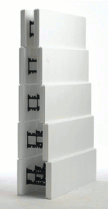Insulated concrete forms features & energy savings
 Insulated Concrete Forms vary in the materials they are made from and their thickness; and also in their web, shape and amount of concrete to be poured into their cavities. Consider carefully these factors, when choosing the ICFs.
Insulated Concrete Forms vary in the materials they are made from and their thickness; and also in their web, shape and amount of concrete to be poured into their cavities. Consider carefully these factors, when choosing the ICFs.
ICF web
Most of the details in the ICF web – the stuff that connects the two sides of the forms – are unimportant.
Insulated Concrete Forms (ICFs) are a prefabricated product for wall construction. They provide a cavity to be filled with concrete, and are typically made of two foam polystyrene insulation layers that become part of the walls.
But be aware to webs made with thermal conductive materials such as steel; they are a source of heat transfer and thermal bridging. Recycled plastic webs are a much better choice.
ICF energy Savings
Obviously, the insulation value of ICF-made walls and floors depends largely on the thickness of their insulation layers and the type of material they are made from.
Though with good R-values, ICF forms fall short of the super-insulation levels required by low-energy homes in cold climates.
Their typical insulation value range from R-17 to R-26, which is insufficent in cold climates and very energy efficient homes.
ICFs are an excellent solution - from an energy efficiency standpoint - in hot and moderate climates, but their standard R-values fall short of the best in very cold climates.
A super-insulation approach is critical for very small heating and cooling systems and huge energy savings, and the R-values of typical ICFs aren't high enough to support it in cold climates.
Some of the most environmentally-friendly ICFs have a small R-value; many styrofoam and mineral wool ICFs have R-values comparable to the most typical ICF products, but forms made with cement-bonded wood fibers have lower insulation quality.
Type and Position of the insulation material
Standard ICFs are made from expanded polystyrene with 50% of the total of the insulation on the interior of the wall (and the other 50% positioned towards its exterior).
But ICFs can be made from other materials: styrofoam, rockwool, cement-bonded recycled with wood... And contrary to standard products these other options may have most or all of their insulation on the exterior - an issue that you should consider carefully. 
Having insulation towards the interior of the walls - as happens with standard ICFs - may have advantages and disadvantages.
The 50%-50% distribution can be advantageous in homes that are heated intermittently; without interior wall insulation, the fabric of the masonry walls will capture and store heat for hours, before releasing it, and the buildings will take a long time to heat up. See Thermal Mass Guide).
The cavity width
The ratio between the amount of concrete to be poured into the ICF forms and the amount of the insulation material of the forms is also a critical issue.
Walls with a thicker “layer” of concrete – often strengthened with reinforced steel – are obviously stronger and with a better seismic- and wind- resistance.
The type of cavity (flat, waffle...) also matters. Flat walls are becoming largely standard, but aren't necessarily the better option in all climates. You should discuss these matters – the shape of the ICF forms, their width, the type of cavity, the insulation thickness of the forms… - with your architect.
Other features
Interlocking grids: ICF interlocking grid systems are becoming standard; they can speed the construction time; forms that only stack together – instead of interlocking - aren't so easy to work with.
Properties: manufacturers with non-standard foam ICF forms like to stress the unique features of their products: fire-resistance (4 hour fire rating), sound-insulation, mold-free, moisture resistance (mineral fiber/rockwool insulation)…
“Custom” ICF products: Some ICF manufacturers offer panelized and large flat sheets, with special sizes, for big projects. They are also offering pre-cut or special assembled units…
Environmental and health concerns: the most environmentally-friendly ICF products are made with recycled expanded polystyrene (styrofoam), mineral fibers (rock-wool) and cement-bonded wood fibers. They can be a greener choice but you shouldn't undervalue insulation or strenght issues.
![]() Related Content
Related Content
![]() Top .... Home Page
Top .... Home Page


